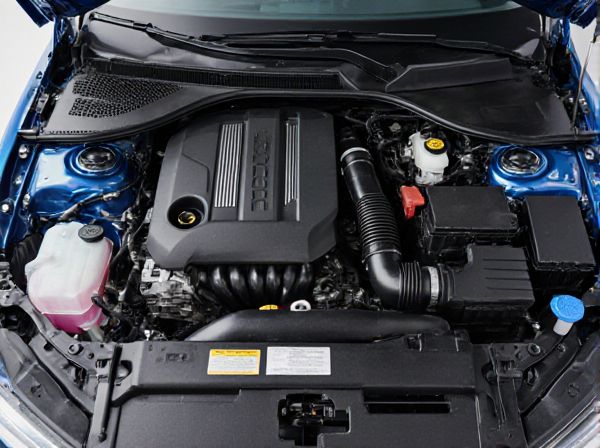
Photo illustration: Single Overhead Cam vs Dual Overhead Cam
Single Overhead Cam (SOHC) engines feature one camshaft per cylinder bank that controls both intake and exhaust valves, offering simpler design and cost-effectiveness. Dual Overhead Cam (DOHC) systems have two camshafts per cylinder bank, allowing greater precision in valve timing, improved airflow, and enhanced engine performance. You can choose SOHC for reliability and economy, while DOHC suits needs for higher power and efficiency.
Table of Comparison
| Feature | Single Overhead Cam (SOHC) | Dual Overhead Cam (DOHC) |
|---|---|---|
| Camshaft Configuration | One camshaft per cylinder head | Two camshafts per cylinder head |
| Valve Operation | Typically operates 2 valves per cylinder | Operates 4 valves per cylinder for better airflow |
| Performance | Moderate power and efficiency | Higher power output and improved efficiency |
| Complexity & Cost | Less complex, lower manufacturing cost | More complex, higher production cost |
| Maintenance | Simpler, easier to maintain | More parts, can require more maintenance |
| Common Usage | Economy cars, older engines | Modern performance and efficiency-focused engines |
Introduction to Overhead Camshaft Designs
Overhead camshaft (OHC) designs play a vital role in engine performance by controlling valve timing with precision. Single Overhead Cam (SOHC) engines use one camshaft per cylinder bank to operate both intake and exhaust valves, providing simplicity and cost-effectiveness. Dual Overhead Cam (DOHC) configurations utilize two camshafts per cylinder bank, allowing independent control of intake and exhaust valves, which enhances airflow, increases RPM potential, and improves overall engine efficiency.
What is a Single Overhead Cam (SOHC)?
A Single Overhead Cam (SOHC) engine features one camshaft located in the cylinder head that controls both intake and exhaust valves, optimizing valve timing for efficient engine performance. SOHC designs are simpler and lighter than Dual Overhead Cam (DOHC) engines, leading to lower production costs and easier maintenance. This configuration is commonly used in compact and mid-sized engines, balancing power output and fuel economy effectively.
What is a Dual Overhead Cam (DOHC)?
A Dual Overhead Cam (DOHC) engine features two camshafts per cylinder head, optimizing valve timing for improved airflow and combustion efficiency. This configuration enables separate control of intake and exhaust valves, enhancing performance and fuel economy compared to Single Overhead Cam (SOHC) designs. DOHC systems are commonly used in modern high-performance and fuel-efficient vehicles due to their ability to support higher engine speeds and more precise valve operation.
Key Differences Between SOHC and DOHC
Single Overhead Cam (SOHC) engines feature one camshaft operating both intake and exhaust valves, resulting in simpler design and lower manufacturing costs. Dual Overhead Cam (DOHC) engines utilize two camshafts per cylinder bank, enabling independent control of intake and exhaust valves, which enhances valve timing precision and improves engine performance. DOHC typically allows for higher RPM and better fuel efficiency compared to SOHC due to optimized valve operation and increased airflow.
Performance Comparison: SOHC vs DOHC
Dual Overhead Cam (DOHC) engines generally offer superior performance compared to Single Overhead Cam (SOHC) engines due to better valve timing control and higher RPM potential. DOHC designs allow for more precise intake and exhaust valve operation with separate cams, enhancing airflow and combustion efficiency. SOHC engines tend to have simpler designs with fewer moving parts, which may result in lower manufacturing costs and reduced complexity but often sacrifice peak power output and tuning flexibility.
Fuel Efficiency: Which Camshaft System Wins?
Single Overhead Cam (SOHC) engines typically offer better fuel efficiency due to their simpler design and reduced friction, resulting in lower mechanical losses. Dual Overhead Cam (DOHC) systems provide enhanced engine performance and higher power output but often at the cost of slightly increased fuel consumption. For drivers prioritizing fuel economy, SOHC engines generally present a more efficient choice, while DOHC engines favor performance-oriented efficiency balances.
Maintenance and Reliability Factors
Single Overhead Cam (SOHC) engines typically have fewer moving parts, resulting in simpler maintenance and lower repair costs compared to Dual Overhead Cam (DOHC) engines. DOHC engines provide better valve timing and performance but may require more frequent inspections and precise adjustments, increasing maintenance complexity. Reliability in SOHC setups is generally higher under routine driving conditions due to less mechanical complexity, while DOHC engines excel in high-performance scenarios but may experience higher wear rates if not properly maintained.
Cost Considerations: SOHC vs DOHC
Single Overhead Cam (SOHC) engines generally have lower manufacturing and maintenance costs due to fewer components and simpler design, making them more budget-friendly for mass-market vehicles. Dual Overhead Cam (DOHC) engines, while more expensive to produce, offer superior performance and efficiency through better valve control and higher RPM capabilities, justifying their higher initial cost in sports and luxury vehicles. The higher precision and complexity of DOHC systems typically lead to increased maintenance costs compared to the more straightforward SOHC setup.
Common Applications in Modern Engines
Single Overhead Cam (SOHC) engines are commonly used in compact cars and motorcycles due to their simpler design, lower cost, and adequate performance for everyday driving. Dual Overhead Cam (DOHC) engines dominate modern high-performance vehicles and sports cars, offering improved valve timing and higher RPM capabilities that enhance power and efficiency. Manufacturers often choose DOHC configurations for turbocharged and multi-valve setups to optimize fuel combustion and emissions control.
Choosing the Right Camshaft for Your Needs
Selecting the right camshaft hinges on your engine performance goals and driving style, with Single Overhead Cam (SOHC) offering simplicity, lower cost, and efficient fuel consumption for everyday use. Dual Overhead Cam (DOHC) setups provide superior valve control, higher RPM potential, and enhanced power output, ideal for high-performance or racing applications. Understanding the trade-offs in complexity, maintenance, and desired horsepower helps in making an informed decision tailored to your automotive needs.
 caratoz.com
caratoz.com